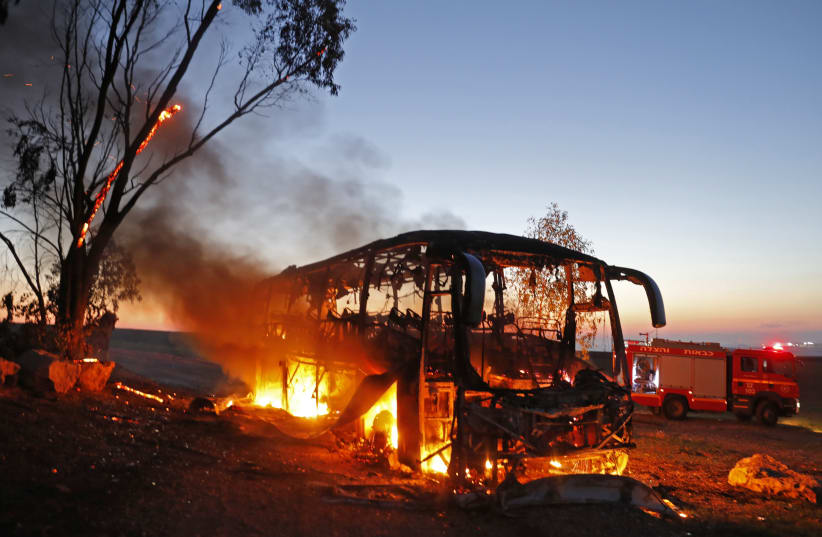In response to the protests, the IDF has “substantially” increased its forces deployed on the Gaza border and all troops have undergone “specially developed trainings designed to replicate the expected elements of the Gaza border events.” Israel has also stationed counterterrorism forces in communities along the Gaza border in order to rapidly respond to any infiltration or military attacks.The IDF has constructed sand berms to provide defenses for IDF forces along the border, and also dug long trenches and laid barbed wire behind these berms in an attempt to delay crowds and vehicles from reaching Israeli civilian communities if a large-scale infiltration succeeds.Hamas’s leader in the Gaza Strip, Yayha Sinwar, has become increasingly more pragmatic as he struggles to cope with the dire humanitarian situation in the enclave and is trying to avoid full-scale war with Israel.But the ruthless hardliner is also building up the military capabilities of Hamas for when the next confrontation explodes. He is continuing to build terrorist cells in the West Bank to carry out attacks against Israelis while at the same time undermining the rule of Palestinian President Mahmoud Abbas.Several months ago, former IDF Chief of Staff Gadi Eisenkot warned that there was a high probability of escalation in the West Bank. In November, Shin Bet (Israel Security Agency) director Nadav Argaman echoed Eisenkot’s warning, saying the relative calm in the area was “deceptive” as “Hamas is trying very hard to carry out terrorist attacks in and from Judea and Samaria.”In Argaman’s November briefing to the Knesset Foreign Affairs and Defense Committee, he said that security forces have thwarted 480 terror attacks in the West Bank, including 219 attacks planned by Hamas cells and 190 planned by lone wolves.According to data released by the Shin Bet, there has been a steady increase of attacks in the West Bank and Jerusalem over the last several months. In October, there were a total of 109 attacks, compared to 116 in November, 138 in December and 138 in January 2019.On Monday, an IDF officer and Border Police soldier were wounded after three Palestinians rammed their car into troops outside a West Bank village near Ramallah. The officer, a company commander in the Kfir Brigade, was seriously wounded and was evacuated to Tel Hashomer Hospital in serious but stable condition.While the economic situation is much better in the West Bank compared to the Gaza Strip, it has gotten much worse since US President Donald Trump’s administration stopped funding for the UN Palestinian refugee agency UNRWA.In mid-February, Israel’s defense cabinet also began withholding Palestinian tax funds and deducted some NIS 500 million ($138m.) from the total sum that is still due to be delivered to the PA. Defense officials believe that the funds provided by Israel were earmarked for the families of Palestinian terrorists held in Israeli prisons.There are also tensions between Israeli officials and Palestinians in prison, after Public Security Minister Gilad Erdan installed disrupters to garble conversations that prisoners have on smuggled cellphones. With violent incidents already having broken out between wardens and inmates over the issue, it is possible that the issue could spill over onto the Palestinian street.In Jerusalem, tensions are also high surrounding the decision of the Waqf – the Muslim custodian of the Temple Mount – to reopen the Bab el-Rahma or Golden Gate which had been closed by Israel since 2003.In late February, dozens of Palestinians clashed with Israeli police as they forced their way through the gate, led by Waqf officials, to hold prayers. According to a report in Haaretz, Waqf officials have now called for mass protests prayers every Friday by the entrance to the site, similar to the mass protest prayers seen after Israel installed metal detectors at the site following a deadly terror attack in 2017.While neither side wants conflict to break out, all the components for a violent explosion between Israel and the Palestinians are in place.All it would take is a small miscalculation.#IDF Chief of Staff Lt.-Gen. Aviv Kochavi seems to have been on the #Gaza border today with the Head of the Southern Command, Maj.-Gen. Hertzi Halevi. About ten thousand #Palestinians demonstrated along the fence during the day, 1 killed and some 24 injured. pic.twitter.com/Un03SwsEUy
— Anna Ahronheim (@AAhronheim) January 25, 2019
Will war between Israel and Hamas break out before elections? - analysis
A continued deterioration of Gaza’s civilian infrastructure will continue to put pressure on Hamas, which could lead to another violent clash with Israel.
